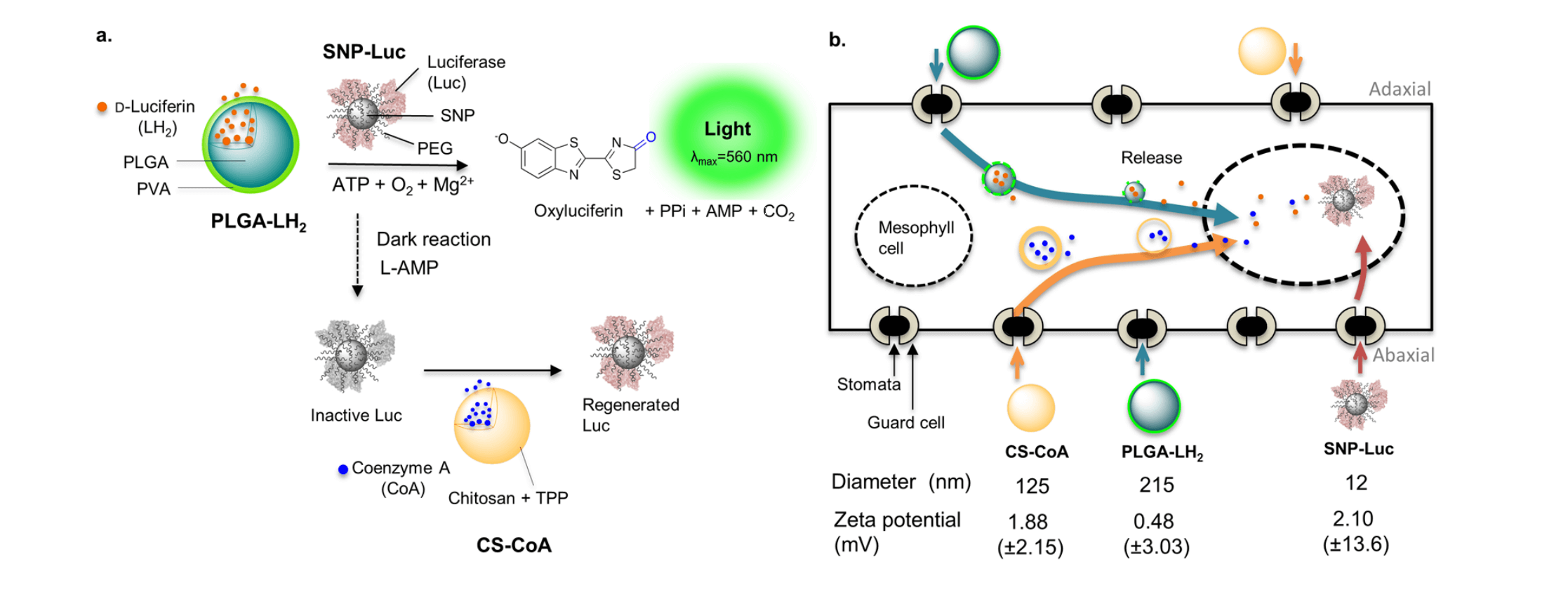Left: Illumination of a book (“Paradise Lost,” by John Milton) with the nanobionic light-emitting plants (two 3.5-week-old watercress plants). The book and the light-emitting watercress plants were placed in front of a reflective paper to increase the influence from the light-emitting plants to the book pages. Right: Glowing MIT logo printed on the leaf of an arugula plant. The mixture of nanoparticles was infused into the leaf using lab-designed syringe termination adaptors. The image is merged of the bright-field image and light emission in the dark. Image credit: Seon-Yeong Kwak
By embedding specialized nanoparticles into the leaves of an aquatic plant species, MIT engineers induced the plants that can give off a dim light for nearly four hours. By developing nanobionic plants they have taken a critical first step toward making the plants that can glow light.
This technology could ultimately be used to provide low-intensity indoor lighting or to transform trees into self-powered streetlights.
The research finding in which MIT postdoc Seon-Yeong Kwak is the lead author was published in the journal Nano Letters.
Involved researchers are hopeful that illumination from nano bionic plants might one day replace some electrical lighting.
Michael Strano, the Carbon P. Dubbs Professor of Chemical Engineering at MIT and the senior author of the study said, "The vision is to make a plant that will function as a desk lamp – a lamp that you don’t have to plugin. The light is ultimately powered by the energy metabolism of the plant itself."
Due to the distinctive features like independent energy generation and storage mechanisms and autonomous self-repair, the engineering of living plants for visible light emission and sustainable illumination has long been a compelling task. But the team of researchers from MIT has done it using silica nanoparticles and demonstrated a plant nanobionic approach that enables exceptional luminosity.
The result they observed was that a mature watercress plant emitting lights greater than 1.44 × 1012 photons/sec or 50% of 1 μW.
This is not the first attempt that the scientists are working to generate light from a plant. Previous attempts to develop light-emitting plants are focused on genetic engineering using either the firefly luciferase gene or bacterial lux operon and is a complicated approach and also is used only in tobacco plants and Arabidopsis thaliana. But Seon-Yeong’s team developed a plant nanobionic approach that utilizes the size and surface charges of four distinct types of a nanoparticle. They used this approach in several common wild-type plants such as spinach, arugula, watercress, and kale. This test plants were selected because of their empirically observed high adenosine triphosphate (ATP) production rates. ATP is the mainly responsible molecule for storing and transferring energy in cells and it is often referred to as the energy currency of the cell.
To utilize ATP to generate light(yellow-green photoemission), the MIT team used the firefly luciferase−luciferin reaction pathway. Organisms like fireflies and bacteria use luciferase to emit light. Luciferase is a generic term for the class of oxidative enzymes that produce bioluminescence.

In the presence of adenosine triphosphate (ATP), oxygen (O2), and magnesium ions (Mg2+), the firefly luciferase (Luc; pink lumps) immobilized silica nanoparticles (SNP-Luc; gray sphere) catalyze the oxidation of luciferin (LH2; orange dots) that is released from luciferin-loaded PLGA nanoparticles (PLGA-LH2; blue-green sphere) encapsulated by a poly(vinyl alcohol) (PVA) layer (yellow-green). Dehydrolucifery-adenylate (L-AMP) is formed as a byproduct, acting as a strong inhibitor of the luciferase. Coenzyme A (CoA; blue dots) released from CoA-encapsulated chitosan nanoparticles (CS-CoA; apricot sphere) opposes this inhibitory effect of L-AMP by triggering the thiolytic reaction, which regenerates luciferase activity.
Then to carry the luciferase they used silica nanoparticles of about 10 nanometers in diameter and they used slightly larger particles of the polymers lactic-co-glycolic acid (PLGA) and chitosan to carry luciferin and coenzyme A, respectively.
Here, coenzyme A helped in removing the reaction byproduct that can inhibit luciferase activity.
They introduce the pressurized bath infusion of nanoparticles (PBIN) to deliver a mixture of nanoparticles to the entire living plant. Before this, they suspended the particles in a solution.
Lactic-co-glycolic acid (PLGA) is a biodegradable and biocompatible copolymer and is used in a host of Food and Drug Administration (FDA) approved therapeutic devices.
The team designed the particles that are releasing luciferin and coenzyme A to accumulate in the extracellular space of mesophyll and the smaller particles carrying luciferase enter the cells that make up the mesophyll. Then luciferin released by PLGA particles enters the plant cells and the luciferase performs the chemical reaction that makes luciferin glow.
Though the intensity of the light generated by one 10-centimeter watercress seedling is currently low (about one-thousandth of the amount needed to read by), the researchers believe they can boost the light emitted, as well as the duration of light, by further optimizing the concentration and release rates of the components.
Strano said, "When those (balancing the reaction rates between the chemical reaction they have created and the rate of the plants' production of fuel) match, you'll have the optimal usage," he said. "If your reaction is too slow, essentially, you'll have a lamp that's too dim. If the reactions are too fast, then you're wasting the fuel inside the plant." He added, "It's a balancing problem."
In future, the researchers at Strano's lab hope to develop a way to paint or spray the nanoparticles onto plant leaves, which could make it possible to transform trees and other large plants into light sources.
Strano said, "Our target is to perform one treatment when the plant is a seedling or a mature plant and have it last for the lifetime of the plant. Our work very seriously opens up the doorway to streetlamps that are nothing but treated trees, and to indirect lighting around homes."
